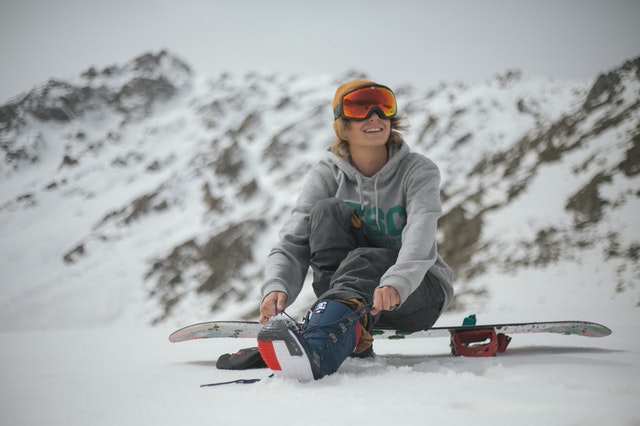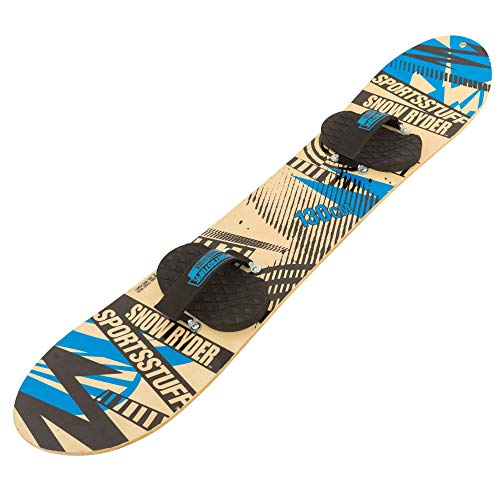New to snowboarding but not sure where to start?
If that’s the case, you’re likely struggling to get all your gear ready to brave the cold, but how much thought have you put into the snowboard itself?
Let us help you get the best snowboard for your skillset and your budget by taking a look at the list we’ve compiled below, the best beginner snowboards complete with pros, cons and small write-ups about their capabilities and why you should consider them.
There’s no one answer to this question, since beginners will all have different strengths and weaknesses, so we’ve tried to include some variety but what makes a good beginner snowboard doesn’t change that much.
Still, this means that our number four could be your number one. The best we can do to answer which snowboards are best for beginners is to include a buyers’ guide and a small FAQ so that you yourself can get educated on what makes a quality snowboard, and decide for yourself which one you want.
Best Beginner Snowboard – Reviews
- Size: 90cm for riders 35-60lbs
- Perfect for Beginners: This snowboard will enter you into the world of cruising' the slopes
- Durable: Hardwood construction for long lasting, repetitive use
- Easy Adjusting: Hook and loop binding allows for them to be adjusted easily
- Note: No metal edge. Not for resort use
- Size: 130cm for riders 80-150lbs
- Perfect for Beginners: This snowboard will enter you into the world of cruising' the slopes
- Durable: Hardwood construction for long lasting, repetitive use
- Easy Adjusting: Hook and loop binding allows for them to be adjusted easily
- Note: No metal edge.Not for resort use
- IDEAL FOR BEGINNER SNOWBOARDERS – This snowboard is appropriate for children ages 5 to 15. Weight limit is upto 95 lbs
- SOLID, QUALITY CONSTRUCTION – Made of a solid polypropylene construction, this kids’ snowboard showcases excellent workmanship.
- ADJUSTABLE BINDINGS – This snowboard has step-in bindings that are adjustable for children of all ages.
- COOL AND STYLISH GRAPHICS – The amazing surface of this board boasts hip and trendy designs.
- TEACHES KIDS BASIC TECHNIQUES – The Free Ride Snowboard can be used to practice easy moves and novice tricks.
- COST EFFECTIVE - Snowboarding is a blast, but it can be expensive to equip kids with all the latest gear. Here’s a way to get the speed, the excitement, and the adrenaline rush of snowboarding…for...
- BEST WINTER FUN - Our all NEW Purple SLEDSTERZ kids Snowboard is shaped to go fast, make turns, and hit bumps and jumps on snow covered hills in the neighborhood.
- EASY TO USE - Insert and secure the bindings from the underside of the board. Riders just hop on, strap in, & start shredding -- no special boots or bindings required -- use regular snow boots or...
- IMPROVED BINDINGS - NEW improved bindings for 2019 fasten securely to the board. They have 3 adjustable settings depending on boot/shoe size and can be reversed for regular or goofy foot riders.
- SPECS - This 40-inch-tall by 10.5-inch-wide snowboard is made of a super-strong polymer and engineered for years of cold-weather fun. Recommended for ages 6 to 12. Also available in blue, red, or...
- Recommended for Ages 4 to 9+ & riders up to 50" tall, boot size up to 6Y
- Heavy duty blow molded design with cold crack additive for durability
- Adjustable ratchet style bindings with quick release to securely keep the rider on the snowboard.
- Designed for sledding hills and backyard use on packed snow
- Perfect for kids who are interested in learning to snowboard
Best Beginner Snowboard – Buyers Guide
How to choose the best snowboard for beginners
Here’s where we’ll go through some of the specs that snowboards have, explaining what they mean and how they translate into a beginner’s snowboarding experience.
A lot more goes into a snowboard than you may realize, having been engineered to perform to incredible standards in some of the harshest elements in the world.
The first thing we should tackle is one of the more obvious factors, the length. You should understand how length changes riding types before trying to make a decision.
Depending on the activities you have planned, for beginners we think it’s best to take a snowboard in the middle of the length range so that you can get a feel for it and have a baseline of what you’re looking for in a snowboard so that you can be free to upgrade or downgrade the length as it suits you.
Otherwise a good general rule to follow is that longer boards are better for freeriding whereas shorter are better for freestyling.
The next logical part of the board to discuss after the length is the width, which is mainly decided by how big your snowboarding boots are. This is because they’ll get mounted perpendicular to the length of the board and must fit snugly and appropriately.
If they don’t then you’re asking for trouble, since a part of your foot touching the floor during a slope will create a hefty amount of drag to almost certainly make you wipeout, or even damage a limb at worst. Your toes and heels should just be over the edge when mounted.
As we’ve seen, there’s different types of snowboards out there for a variety of different styles, all of which are made with size, engineering and build in mind. Freeriding boards are, as the name suggests, for riding free in the wild. It can be used for off-trail and mountains where more sensitive slope stuff won’t.
Freestyling boards are for terrain park riding and perform better in other controlled environments. They become difficult to control in powder, so be careful. Speaking of power, the next type is power boards which, surprise, do very well on freshly lain, powdery snow.
Once again, this type suffers on groomed runs due to their specialized nature. Finally, we have the all-mountain board which is designed for all mountains, all the time, without the negatives of freestyling and power boards.
They make for unremarkable boards usually, but that’s exactly why we’d recommend this type to a beginner in snowboarding so that they can get a feel for an all-rounder board.
Snowboard shapes can also vary to help riders achieve certain performances. This will be dependent on your riding style and which slopes you’ll be tackling. Boards that are symmetrical in their design are called twin tip boards, and they ride well no matter which direction you’re going.
On the flipside, there’s asymmetrical boards which tend to be stiffer at the tip or tail, or purposely unequal profiles so that they can turn harder and sharper than other boards at the heelside but softer at the toeside.
Then there’s dimension boards which have, well, dimensions which focus them into being used in a singular direction. They’re great for freeriding. You can ride them switch if you’re that committed to it, but they won’t be anywhere near as efficient.
Finally, the last important part of a snowboard’s shape you should know is whether it’s rocker or camber, and what those two terms even mean.
Rocker could be described as a very slight upturn where the snowboard’s center comes into contact with the snow in such a way that the tip and the tail are elevated.
Logically following then, camber is the opposite where the snowboard is bent slightly downwards so that the tip and tail get more contact with the snow than the center does. So, what’s the difference?
When you’re on them, the entire board is flat anyway so it’s more about spreading pressure equally across the snowboard for both styles.
The styles aren’t even mutually exclusive. Boards that are more cambered tend to have better control whereas rockered boards are more agile in how you can move and turn them.
Where flexing is concerned, beginners should opt for soft flex boards. They bend easier than other, stiffer boards and this makes them easier to turn, which you’ll appreciate when you’re rushing headlong into a poor aspen tree.
Soft flex will be good to correct for the mistake you will make while also instilling some confidence in your snowboarding ability. Stiff boards obviously perform better and is what the professionals use, but if you’re reading this then you’re probably not there yet.
Frequently Asked Questions
What’s the best snowboard profile for terrain parks?
Terrain parks are where the most tricks are usually performed, so for park boarding you’ll want a board that can execute whichever particular trick you want to show-off while not being too specialized to barely function as your average board.
We think a twin-tip board could do the trick, since they are absolutely symmetrical and perform the same no matter which foot gets used. This means the board lacks direction, too, which allows for plenty of tricks that involve switching up your feet on the board.
If you’re a beginner then you should know that a flat board is better if you’re planning on grinding, but it’ll give you less pop and so more flat air. Otherwise, a normal rocker-camber profile should suffice.
What’s sidecut and why do I need it?
In skiing and snowboarding geometry, sidecut is the difference between the board’s middle compared to the nose and tail so that it tapers in slightly at the center. It’s a big design feature in modern snowboards and skis since the tapering in creates part of a circle’s radius.
This helps the snowboard drive through the snow on a consistent circle-shaped path when you turn the board onto its edge. As you can imagine, it’s invaluable for turning so that you can be agile but not sacrifice stability.
What is P-Tex and why is it used?
P-Tex is just the tradename of a material you’ve probably heard of before, polyethylene. P-Tex is the polyethylene base material that most snowboards and skis are made from. It’s a very specific type of plastic that can absorb wax, which improves glide, control and predictability of the board for the snowboarder, if you were wondering.
P-Tex provides snowboards with a smooth, wax-friendly base so that you won’t experience dragging or sticking. When snowboards sustain damage from the wilder slopes out there, P-Tex is what they use to repair so that the board can stay as consistent as possible in its construction.







